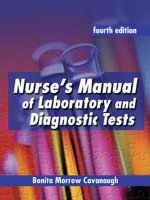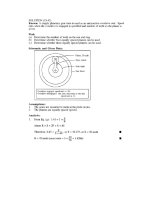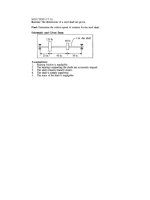Washington manual of hematology and oncology 3rd ed subspeciality consult
Bạn đang xem bản rút gọn của tài liệu. Xem và tải ngay bản đầy đủ của tài liệu tại đây (14.13 MB, 719 trang )
2
Acquisitions Editor: Sonya Seigafuse
Product Manager: Kerry Barrett
Vendor Manager: Bridgett Dougherty
Marketing Manager: Kimberly Schonberger
Manufacturing Manager: Ben Rivera
Design Coordinator: Stephen Druding
Editorial Coordinator: Katie Sharp
Production Service: Aptara, Inc.
© 2012 by Department of Medicine, Washington University
School of Medicine
Printed in China
All rights reserved. This book is protected by copyright. No part of this
book may be reproduced in any form by any means, including
photocopying, or utilized by any information storage and retrieval system
without written permission from the copyright owner, except for brief
quotations embodied in critical articles and reviews. Materials appearing in
this book prepared by individuals as part of their official duties as U.S.
government employees are not covered by the above-mentioned
copyright.
Library of Congress Cataloging-in-Publication Data
The Washington manual hematology and oncology subspecialty consult. —
3rd ed. / editors, Amanda Cashen, Brian A. Van Tine.
p. ; cm. — (Washington manual subspecialty consult series)
Hematology and oncology subspecialty consult
Includes bibliographical references and index.
ISBN 978-1-4511-1424-9 (alk. paper) — ISBN 1-4511-1424-9 (alk.
paper)
I. Cashen, Amanda. II. Van Tine, Brian A. III. Title: Hematology and
oncology subspecialty
consult. IV. Series: Washington manual subspecialty consult series.
[DNLM: 1. Hematologic Diseases—Handbooks. 2. Diagnosis, Differential
3
—
Handbooks. 3. Drug Therapy—methods—Handbooks. 4. Neoplasms—
Handbooks. WH 39]
616.1’5—dc23
2011046133
The Washington Manual™ is an intent-to-use mark belonging to
Washington University in St. Louis to which international legal protection
applies. The mark is used in this publication by LWW under license from
Washington University.
Care has been taken to confirm the accuracy of the information
presented and to describe generally accepted practices. However, the
authors, editors, and publisher are not responsible for errors or omissions
or for any consequences from application of the information in this book
and make no warranty, expressed or implied, with respect to the currency,
completeness, or accuracy of the contents of the publication. Application of
the information in a particular situation remains the professional
responsibility of the practitioner.
The authors, editors, and publisher have exerted every effort to ensure
that drug selection and dosage set forth in this text are in accordance with
current recommendations and practice at the time of publication.
However, in view of ongoing research, changes in government regulations,
and the constant flow of information relating to drug therapy and drug
reactions, the reader is urged to check the package insert for each drug for
any change in indications and dosage and for added warnings and
precautions. This is particularly important when the recommended agent is
a new or infrequently employed drug.
Some drugs and medical devices presented in the publication have Food
and Drug Administration (FDA) clearance for limited use in restricted
research settings. It is the responsibility of the health care provider to
ascertain the FDA status of each drug or device planned for use in their
clinical practice.
To purchase additional copies of this book, call our customer service
department at (800) 638-3030 or fax orders to (301) 223-2320.
International customers should call (301) 223-2300.
4
Visit Lippincott Williams & Wilkins on the Internet: at LWW.com. Lippincott
Williams & Wilkins customer service representatives are available from
8:30 am to 6 pm, EST.
10 9 8 7 6 5 4 3 2 1
5
George Ansstas, MD
Clinical Fellow
Division of Hematology/Oncology
Washington University School of Medicine
St. Louis, Missouri
Michael Ansstas, MD
Resident Physician
Department of Medicine
Saint Louis University School of Medicine
St. Louis, Missouri
Kristan M. Augustin, PharmD, BCOP
Clinical Pharmacist
BMT/Leukemia
Department of Pharmacy
Barnes-Jewish Hospital
St. Louis, Missouri
Leigh M. Boehmer, PharmD, BCOP
Clinical Pharmacist
Department of Pharmacy
Barnes-Jewish Hospital
St. Louis, Missouri
Sara K. Butler, PharmD, BCOP, BCPS
Clinical Pharmacist
6
Department of Pharmacy
Barnes-Jewish Hospital
St. Louis, Missouri
Amanda Cashen, MD
Assistant Professor of Medicine
Section of Leukemia and Stem Cell Transplantation
Washington University School of Medicine
St. Louis, Missouri
Yee Hong Chia, MD
Clinical Fellow
Division of Hematology/Oncology
Washington University School of Medicine
St. Louis, Missouri
Kim French, APRN-BC
Division of Hematology
Washington University School of Medicine
St. Louis, Missouri
Armin Ghobadi
Clinical Fellow
Division of Hematology/Oncology
Washington University School of Medicine
St. Louis, Missouri
Andrea R. Hagemann, MD
Assistant Professor
Department of Obstetrics and Gynecology
Washington University School of Medicine
St. Louis, Missouri
Lindsay M. Hladnik, PharmD, BCOP
7
Clinical Pharmacist
Department of Pharmacy
Barnes-Jewish Hospital
St. Louis, Missouri
Xiaoyi Hu, MD, PhD
Fellow
Division of Hematology/Oncology
Washington University School of Medicine
St. Louis, Missouri
Amie Jackson, MD
Resident
Department of Medicine
Washington University School of Medicine
St. Louis, Missouri
Ronald Jackups, MD
Chief Resident
Laboratory and Genomic Medicine
Washington University School of Medicine
St. Louis, Missouri
Kian-Huat Lim, MD, PhD
Fellow
Medical Oncology
National Cancer Institute/National Institutes of Health
Bethesda, Maryland
Daniel J. Ma, MD
Resident Physician
Department of Radiation Oncology
Washington University School of Medicine
St. Louis, Missouri
8
Paul Mehan, MD
Fellow
Division of Hematology/Oncology
Washington University School of Medicine
St. Louis, Missouri
Ali McBride, PharmD, BCPS
Clinical Pharmacist
Department of Pharmacy
Barnes-Jewish Hospital
St. Louis, Missouri
Gregory H. Miday, MD
Resident
Department of Medicine
Washington University School of Medicine
St. Louis, Missouri
Gayathri Nagaraj, MD
Fellow
Division of Hematology/Oncology
Washington University School of Medicine
St. Louis, Missouri
Parag J. Parikh, MD
Assistant Professor
Department of Radiology Oncology
Washington University School of Medicine
St. Louis, Missouri
Parvin F. Peddi, MD
Fellow
Division of Hematology/Oncology
Washington University School of Medicine
St. Louis, Missouri
9
Aruna Rokkam, MD
Fellow
Division of Hematology/Oncology
Washington University School of Medicine
St. Louis, Missouri
Cesar Sanchez, MD
Fellow
Division of Hematology/Oncology
Washington University School of Medicine
St. Louis, Missouri
Kristen M. Sanfilippo, MD
Fellow
Division of Hematology/Oncology
Washington University School of Medicine
St. Louis, Missouri
Brian A. Van Tine, MD, PhD
Assistant Professor of Medicine
Division of Medical Oncology
Washington University School of Medicine
St. Louis, Missouri
Tzu-Fei Wang, MD
Clinical Fellow
Department of Medicine
Division of Hematology/Oncology
Washington University School of Medicine
St. Louis, Missouri
Saiama Waqar, MD
Instructor
10
Division of Medical Oncology
Washington University School of Medicine
St. Louis, Missouri
Israel Zighelboim, MD
Assistant Professor
Department of Obstetrics and Gynecology
Division of Obstetrics and Gynecology Oncology
Washington University School of Medicine
St. Louis, Missouri
Imran Zoberi, MD
Assistant Professor
Department of Radiation Oncology
Washington University School of Medicine
St. Louis, Missouri
11
t is a pleasure to present the new edition of The Washington Manual®
Subspecialty Consult Series: Hematology/Oncology Subspecialty Consult. This
pocket-size book continues to be a primary reference for medical students, interns,
residents, and other practitioners who need ready access to practical clinical
information to diagnose and treat patients with a wide variety of disorders. Medical
knowledge continues to increase at an astounding rate, which creates a challenge for
physicians to keep up with the biomedical discoveries, genetic and genomic
information, and novel therapeutics that can positively impact patient outcomes. The
Washington Manual Subspecialty Series addresses this challenge by concisely and
practically providing current scientific information for clinicians to aid them in the
diagnosis, investigation, and treatment of common medical conditions.
I want to personally thank the authors, which include house officers, fellows,
and attendings at Washington University School of Medicine and Barnes-Jewish
Hospital. Their commitment to patient care and education is unsurpassed, and their
efforts and skill in compiling this manual are evident in the quality of the final
product. In particular, I would like to acknowledge our editors, Drs. Amanda Cashen
and Brian A. Van Tine, and the series editors, Drs. Katherine Henderson and Tom
De Fer, who have worked tirelessly to produce another outstanding edition of this
manual. I would also like to thank Dr. Melvin Blanchard, Chief of the Division of
Medical Education in the Department of Medicine at Washington University School
of Medicine, for his advice and guidance. I believe this Subspecialty Manual will
meet its desired goal of providing practical knowledge that can be directly applied
at the bedside and in outpatient settings to improve patient care.
Victoria J. Fraser, MD
Dr. J. William Campbell Professor
Interim Chairman of Medicine
Co-Director of the Infectious Disease Division
Washington University School of Medicine
12
13
e are pleased to present the third edition of The Washington Manual™
Hematology and Oncology Subspecialty Consult. The field of medical oncology
continues to advance at a remarkable pace. Every year, new indications are found
for existing therapies and new anti-cancer drugs are approved. Staging systems,
classifications, and prognostic models are in flux, reflecting the discovery of new
biomarkers, changes in treatment algorithms, and the general improvement in patient
outcomes. Therapeutic advances have also been made in benign hematology,
particularly with the introduction of novel anticoagulants.
This edition has been updated to include new standards in the treatment of
malignancies and hematologic disorders, mechanisms of action of new therapeutic
agents, and current use of molecular prognostic factors. The information in each
chapter is now presented in a consistent format, with important references cited. Our
goal is to provide a concise, practical reference for fellows, residents, and medical
students rotating on hematology and oncology subspecialty services. Most of the
authors are hematology–oncology fellows or internal medicine residents, the
physicians who have recent experience with the issues and questions that arise in the
course of training in these subspecialties. Primary care practitioners and other health
care professionals also will find this manual useful as a quick reference source in
hematology and oncology.
As the practice of hematology and oncology continues to evolve, changes in
dosing and indications for chemotherapy and targeted therapies will occur, and
staging systems will be modified. We recommend a handbook of chemotherapy
regimens and an oncology staging manual to complement the information in this
book. And of course, clinical judgment is imperative when applying the principles
presented here to the care of individual patients.
We appreciate the effort and expertise of everyone who contributed to this
edition of the Hematology and Oncology Subspecialty Consult. In particular, we
would like to thank the authors for their enthusiastic efforts to distill volumes of
medical advances into a concise, useable format. We also recognize the faculty in
the divisions of hematology, oncology, bone marrow transplantation, radiation
14
oncology, and gynecologic oncology at Washington University for their mentorship
and commitment to education.
—A.C. and B.A.V.T.
15
Contributing Authors
Chairman’s Note
Preface
PART I. HEMATOLOGY
1. Introduction and Approach to Hematology
Parvin F. Peddi
2. White Blood Cell Disorders: Leukopenia and Leukocytosis
George Ansstas
3. Red Blood Cell Disorders
George Ansstas
4. Platelets: Thrombocytopenia and Thrombocytosis
Gregory H. Miday and Paul Mehan
5. Introduction to Coagulation and Laboratory Evaluation of Coagulation
Tzu-Fei Wang
6. Thrombotic Disease
Tzu-Fei Wang
7. Coagulopathy
Tzu-Fei Wang
8. Myelodysplasia, Bone Marrow Failure Syndromes, and Other Causes of
Pancytopenia
Yee Hong Chia
9. Myeloproliferative Disorders
16
George Ansstas
10. Transfusion Medicine
Ronald Jackups and Tzu-Fei Wang
11. Sickle Cell Disease
Kim French
12. Drugs that Affect Hemostasis: Anticoagulants, Thrombolytics, and
Antifibrinolytics
Amanda Cashen
13. Plasma Cell Disorders
Kristen M. Sanfilippo
PART II. ONCOLOGY
14. Introduction and Approach to Oncology
Gayathri Nagaraj
15. Cancer Biology
Kian-Huat Lim
16. Chemotherapy
Kristan M. Augustin, Lindsay M. Hladnik, Sara K. Butler, Ali McBride, and Leigh
M. Boehmer
17. Introduction to Radiation Oncology
Daniel J. Ma, Parag J. Parikh, and Imran Zoberi
18. Breast Cancer
Yee Hong Chia, Gayathri Nagaraj, and Cesar Sanchez
19. Lung Cancer
Saiama Waqar
20. Colorectal Cancer
Aruna Rokkam
21. Other Gastrointestinal Malignancies
Kian-Huat Lim
17
22. Malignant Melanoma
Gregory H. Miday and Yee Hong Chia
23. Head and Neck Cance
George Ansstas
24. Sarcoma
Brian A. Van Tine
25. Endocrine Malignancies
Parvin F. Peddi
26. Urological Malignancies
Parvin F. Peddi
27. Gynecologic Oncology
Andrea R. Hagemann and Israel Zighelboim
28. Brain Tumors
Xiaoyi Hu
29. Leukemias
George Ansstas
30. Lymphoma
Amie Jackson and Kristen M. Sanfilippo
31. Introduction to Hematopoietic Stem Cell Transplantation
Armin Ghobadi
32. Human Immunodeficiency Virus–Related Malignancies
Xiaoyi Hu
33. Cancer of Unknown Primary
Gayathri Nagaraj
34. Supportive Care in Oncology
Brian A. Van Tine
35. Oncologic Emergencies
18
Michael Ansstas
Index
19
GENERAL PRINCIPLES
Approach to the Hematology Patient
Hematologic diseases are a heterogeneous group of diseases that can have
multiple clinical and laboratory manifestations that mimic nonhematologic diseases.
History, physical exam, labs, peripheral smear, and bone marrow biopsy are critical
in making the correct diagnosis. The diseases can be approached by identifying the
primary hematologic component that is affected: RBCs, WBCs, platelets, or the
coagulation system. The major abnormalities in hematology are quantitative in
nature, with either excessive or deficient production of one of the hematopoietic
constituents (e.g., leukemias, anemias). Qualitative abnormalities that can be
inherited (e.g., sickle cell disease) or acquired also occur.
DIAGNOSIS
Clinical Presentation
History
The medical history is, of course, the first step in hematology diagnostic
assessment. Table 1-1 offers some general questions for evaluation of a hematologic
disorder.
Physical Exam
20
The physical exam is also an important part of the diagnostic process. Along
with the history, it can suggest a diagnosis, guide lab testing, and aid in the
differential diagnosis. Table 1-2 offers some general physical exam findings that are
useful in the hematology patient.
Diagnostic Testing
Laboratories
The clinician should be comfortable using the complete blood count (CBC) and
peripheral smear to evaluate patients for possible hematologic disorders. Patients
may be referred to a hematologist based on a lab abnormality that is drawn for a
reason other than the diagnosis of a primary hematologic disorder. There are certain
limiting values in hematology that can help exclude or confirm the need for further
testing or warn us of the possibility of potential physiological consequences (see
Table 1-3).
The Peripheral Smear. The visual study of peripheral blood is
necessary to diagnose hematologic and nonhematologic diseases, for
example, thrombotic thrombocytopenic purpura or malaria. In these
cases, as in others, automated hematology analyzers are able to provide
a large number of data regarding all the blood cells but will not be able
to detect subtle anomalies critical in the diagnosis.
21
Slides for a peripheral smear are typically prepared either by automated
methods or by qualified technicians in a specialized laboratory. This step is critical
since poorly processed samples can lead to incorrect diagnoses. Smears may be
prepared on glass slides or coverslips. Ideally, blood smears should be prepared
from uncoagulated blood and from a sample collected from a finger stick. In
practice, most slides are prepared from blood samples containing anticoagulants and
are thus prone to the introduction of morphologic artifacts. Blood smears are
normally stained using Wright or May–Grünwald–Giemsa stain.
22
Examination of the Peripheral Smear. Examination of the smear
should proceed systematically and begin under low power to identify a
portion of the slide with optimal cellular distribution and staining, which
normally corresponds to the thinner edge of the sample. As a general
rule, the analysis starts with RBCs, continues with leukocytes,
and finishes with platelets. Under low power (×10 to ×20) it is
possible to analyze general characteristics of RBCs to discover, for
example, the presence of Rouleaux associated with multiple myeloma,
estimate the WBC and platelet counts, and determine the presence of
abnormal populations of cells, such as blasts, by scanning over the entire
23
smear. Under high power (×100), each of the cell lineages is examined
for any abnormalities in number or morphology.
Red Blood Cells. Quantitative analysis of RBCs is difficult on a
peripheral smear. Automated analyzers are used to calculate:
MCHC, the mean cell Hgb concentration, expressed as grams per
deciliter;
MCH, the mean corpuscular Hgb, expressed as picograms; and
MCV, the mean corpuscular volume, expressed as femtoliters (10−15 L).
Qualitative analysis of RBCs should demonstrate uniform round cells with
smooth membranes and a pale central area with a round rim of red Hgb. Variations
24
in size are called anisocytosis, and variations in shape, poikilocytosis. The
following abnormalities may be observed:
Hypochromia corresponds to a very thin rim of Hgb and a larger
central pale area. These red cells are often microcytic and are seen in
iron deficiency, thalassemias, and sideroblastic anemia.
Microcytosis (<6 μm): Differential diagnosis includes iron-deficiency
anemia, anemia in chronic disease, thalassemias, and sideroblastic
anemia. These cells are usually hypochromic and have prominent central
pallor.
Macrocytosis (>9 μm in diameter): Differential diagnosis includes liver
disease, alcoholism, aplastic anemia, and myelodysplasia. Megaloblastic
anemias (B12 and folate deficiencies) have macro-ovalocytes (large oval
c e l l s ) . Reticulocytes
are
large
immature
red
cells
with
polychromatophilia.
Schistocytes (fragmented cells) are caused by mechanical disruption of
cells in the microvasculature by fibrin strands or by mechanical prosthetic
heart valves. Differential diagnosis includes thrombotic thrombocytopenic
purpura/hemolytic uremic syndrome, disseminated intravascular
coagulation, hemolysis/elevated liver enzymes/low platelet count
(HELLP) syndrome, and malignant hypertension.
Acanthocytes (spiculated cells with irregular projections of varying
length) are seen in liver disease.
Burr cells (cells with short, evenly spaced cytoplasmic projections) may
be an artifact of slide preparation or found in renal failure and uremia.
Bite cells (cells with a smooth semicircle extracted) are due to spleen
phagocytes that have removed Heinz bodies consisting of denatured
Hgb. They are found in hemolytic anemia due to glucose-6-phosphate
dehydrogenase deficiency.
Spherocytes (round, dense cells with absent central pallor) are seen in
immune hemolytic anemia and hereditary spherocytosis.
Sickle cells (sickle-shaped cells) are due to polymerization of Hgb They
are found in sickle cell disease but not in sickle cell trait.
Target cells (cells with extra Hgb in the center surrounded by a rim of
pallor; bull’s-eye appearance) are due to an increase in the ratio of cell
membrane surface area to Hgb volume within the cell. These have a
central spot of Hgb surrounded by a ring of pallor from the redundancy in
cell membrane. They are found in liver disease, postsplenectomy, in
25

![scott fogler - elements of chemical reaction engineering [3rd ed.]](https://media.store123doc.com/images/document/14/ri/ii/medium_Z7Fj1umpAL.jpg)







